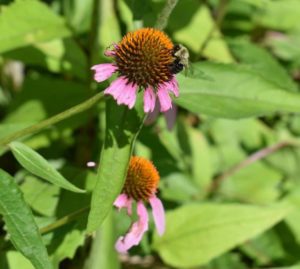Hello Fellow Readers, I have an assortment of deformed and dwarfed flowers on my Black-eyed Susan (Rudbeckia) and Coneflower (Echinacea). In addition to distorted petals, some flowers didn’t form at all. Plus, the ends of others look like something nibbled them off.
This year, the foliage looks terrific, unlike the last two when riddled with powdery mildew from being overly wet. This summer is on the dry side with plenty of heat, and the happy plants held the promise of a plethora of blooms—instead, it’s a confusing dilemma. On went the research cap.
Is the dilemma Tarnished Plant Bugs or Lace Bugs?
I learned about tarnished plant bugs (Lygus lineolaris) that can disfigure leaves and flower buds on rudbeckias and echinacea, causing them not to bloom. Or the flowers have petals only on one side.
There’s Lace Bugs, a large family of insects that also sucks the sap out of leaves, disfiguring them. I’ve seen a few of the small (1/8th to 3/8th an inch long) lacey-winged things flying around. But it’s the tiny black spots under the leaves called frass (a polite way of saying bug poop) that points to them maybe being the culprit.
Or thrips?
Or is it tiny thrips (1/25th an inch long) attracted to yellow, white, and light-colored flowers sucking the daylights out of them? In major infestations, the plants themselves become deformed and splotchy. Hmmm, not the case with mine. But if so, like with the beforementioned bugs, insecticidal soap, or my tried-and-true Neem Oil will do the trick. Plus, cleaning up the garden in the fall limits their overwintering there, though contrary to my desire to keep the dry seed heads standing for our feathered friends.
Sadly, it’s Aster Yellows for which there is no cure.
After sifting through all these maladies, I’ve narrowed the dilemma down to Aster Yellows, which affects over 300 species of plants, including vegetables like potatoes and carrots. It is caused by a pathogen called phytoplasma transmitted primarily by leafhoppers. By the time symptoms appear, initially often yellowing foliage before the deformed or dwarfed flowerheads, it’s too late. There is no cure. Removing the infected plants, including the roots, is the only way to end the cycle of spreading the disease to other plants. Toss all the plant parts into a plastic bag and in the regular trash—a sad end to beautiful plants.

Miss Ellie Mae & I at “The Top of the World“
A personal note about our dear Miss Ellie
Before I sign off, if I may share news about Miss Ellie, we learned that she has cancer for which there is no treatment. As you know, Miss Ellie is the mascot for our column since we began our weekly chats. She arrived unexpectedly eleven years ago during a tough time of transition. I’m doubly blessed as Curt came into my life about the same time. Together we shared a journey of recovery. Ellie, from the neglect and isolation of living alone in a cage, rarely fed or watered, with no protection from the hot Georgian sun. I from the years of neglect and loneliness of addiction.
Ellie was about a year old when she arrived, making her about twelve now— a long life for golden, but it never seems long enough. We will cherish all the days we still have. Thank you, kind readers, for your loving thoughts and prayers. Garden Dilemmas? AskMaryStone@gmail.com (and now on your favorite Podcast App.)
Though it’s sad to lose beautiful plants riddled with disease, there is the hope of renewal and memories that will last forever.
Tune in to the Garden Dilemmas Podcast featuring this story.
Click through to learn more about Aster Yellows.
Column updated 8/22/21






Mary, a couple stocks on one of my Black eyed Susan plants are wide and the blossoms weird – elongated centers. I was showing my sister and when she got home in Vt found a few on her Coneflowers. Do you have any idea the problem? I have photos but wasn’t sure how to share them.
Hi Dorrie, I can’t say as I’ve seen elongated centers on Black-eyed Susans. Yes, please send photos to AskMaryStone@gmail.com and hopefully can get to the bottom of your garden dilemma. Thanks for your message and for reading my column, Mary
Hi Mary,
A few of my black eyed susans have petals coming out of their brown centers. Someone said they thought it was aster yellows. Some of the flowers have brown petals, don’t think any are dwarfed. I do have an echinacea I recently bought, still in its pot, that has flowers with really small petals… But it got really dry and almost died while I was away so I thought that might be the cause. What do you think? Do we have aster yellows? Wondering how we can know for sure. Thank you!!
Hello Andrea, Well, that is a mystery. It sounds like it could be Aster Yellows, but I would check with your local Extension Office to be sure. Thanks for reading my column, Mary